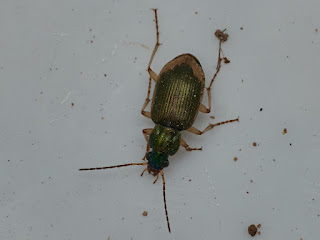Wednesday 27th September 2023, Mason's Bank and Lower Shortdich Turbary SWT Reserves
This outing was a casualty of the threatened bad weather caused by Storm Agnes.
Wednesday 4th October 2023, Stanmore Country Park
First the good news …
The weather was fine and allowed the visit to go ahead. After the two cancellations on the previous Wednesdays due to rain, this was a huge relief.
A new species of fly for Shropshire was found, Polyporivora picta. This is a member of the Platypezidae family, which are known collectively as Flat-footed flies, whose larvae feed on fungi. It is quite an attractive fly.
 |
| Photograph: John Martin |
The first adult Turtle shieldbug, Podops inuncta, for the county was found. Nymphs were found last year at two sites, but there had been no sightings of adults, until this outing.
 |
| Photograph: David Williams |
And now the bad news …
I was away on holiday and missed all the fun. That’s life!
Stanmore Country Park is situated about a mile to the east of Bridgnorth. It is part of a former RAF camp and has been converted into woodland and open areas of grassland, with a good network of paths.
An industrial estate shares the former camp site and the approach road to that estate splits the reserve into two. The car park is off the approach road.
From the car park most of the users tend to go into the nearest part of the reserve.
Joy of Wildlife bucked the trend and went over the road to the other side!
The site was mainly a flat area of secondary woodland with some large glades, which is where the group tended to congregate, especially around any benches that could be found.
 |
| Photograph: Neil Nash |
Here are photographs of some of the animals that were found during the day starting with a red and black rhopalid bug, Corizus hyoscyami.
 |
| Photograph: Neil Nash |
A Ruby tiger moth larva.
 |
| Photograph: John Martin |
A Walnut orbweb spider, Nuctenea umbratica.
 |
| Photograph: Neil Nash |
A Forest bug nymph, Pentatoma rufipes.
 |
| Photograph: David Williams |
A hornet, Vespa crabro.
 |
| Photograph: Neil Nash |
A Box bug, Gonocerus acuteangulatus.
 |
| Photograph: David Williams |
A rather splendid shiny gall wasp, Ormyrus nitidulus, which was found on oak.
 |
| Photograph: Nigel Jones |
A Tortoise bug, Eurygaster testudinaria.
 |
| Photograph: Neil Nash |
And finally a tiny, flightless, parasitic wasp, Callitulla pyrrhogaster.
 |
| Photograph: David Williams |
Since we first found this distinctive wasp, it has become a challenge to try and find one on every outing!
Normally we would not attempt to identify parasitic wasps but we have been assured that its size, colouring and lack of fully formed wings allow it to be identified in the field.
My thanks to Shropshire County Council for permitting us to do what we enjoy doing. My immense gratitude to Neil and Jim for providing the information about the trip which I have paraphrased in this report and to the photographers for providing their images..
Wednesday 11th October 2023, Lyth Hill
This was another victim of the weather as forecast persistent and heavy rain caused the outing to be cancelled.
Other News
You may have noticed a lot of Red admiral butterflies recently when you have been out and about.
Well our photographer spotted over twenty in a feeding frenzy on some windfall damsons in his garden.
Here are a few.
 |
| Photograph: Bob Kemp |
The Shropshire Spider Group managed, after a lot of negotiation and last-minute hitches, to gain access to Condover Quarry, a large sand and gravel quarry.
The group was met by the company’s ecologist who gave an introduction to the site then guided us to parts of the site where quarrying had ceased, and the vegetation re-established.
After a long walk a “base” was set up on a sandy bank below and opposite extensive areas of grassland with woodland and a pool nearby. Here are some of the animals found on forays from this base.
A 24-spot ladybird.
 |
| Photograph: Nigel Cane-Honeysett |
A Slender ground hopper.
 |
| Photograph: David Williams |
Being a Spider Group meeting I had better include a spider. This is one of the many species of wolf spiders, Arctosa perita.
 |
| Photograph: Nigel Cane-Honeysett |
A Blue shieldbug.
 |
| Photograph: David Williams |
A weevil, Sitona waterhousei.
.jpg) |
| Photograph: Nigel Cane-Honeysett |
A sawfly larva, Platycampus luridiventris.
 |
| Photograph: David Williams |
Another weevil, Trachyphloeus alternans.
 |
| Photograph: Nigel Cane-Honeysett |
A large staphylinid beetle known as a Devil’s coach-horse.
 |
| Photograph: David Williams |
And a third weevil, Otiorhynchus ligneus.
.jpg) |
| Photograph: Nigel Cane-Honeysett |
A large distinctive ground beetle, Chlaenius vestitus.
 |
| Photograph: David Williams |
And to finish a puzzle.
Wet sand is good for preserving footprints, but what animal left these?
.jpg) |
| Photograph: Nigel Cane-Honeysett |
Badger has been suggested but the jury is still out.


























No comments:
Post a Comment
Please feel free to comment on this post...